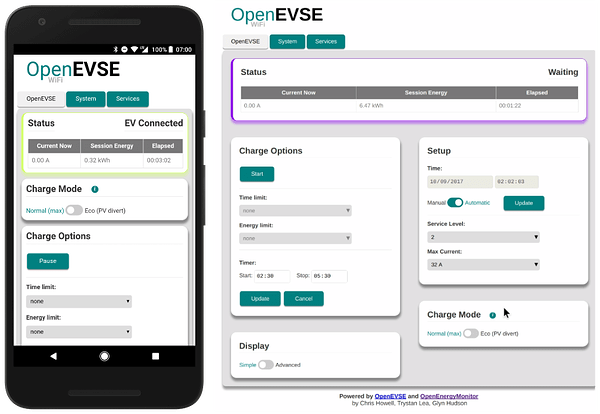Note that the plain LoRa you’ve added so far is not LoRaWAN (and hence is not related to The Things Network, nor to this forum).
I guess you’ll need some security, which LoRaWAN could add out of the box.
But LoRa(WAN) devices cannot transmit a lot of data (“uplinks” are very limited in both size and frequency/quantity), and sending data to the device (“downlink”) is even more limited. So there’s no way LoRa or LoRaWAN can replace the WiFi to support the built-in web server like the image below that I grabbed from their GitHub repo, if that’s what you’re expecting:
But of course, one could host such web application on another server, and only transfer the data between the device and that server. That GitHub repo says:
OpenEVSE can post its status values (e.g. amp, wh, temp1, temp2, temp3, pilot, status) to an MQTT server. Data will be published as a sub-topic of base topic. E.g <base-topic>/amp. Data is published to MQTT every 30s.
You won’t be able to transmit the same data every 30 seconds with LoRaWAN. Even if the data is only 10 bytes, then in best conditions such would take 62 milliseconds per message, so on the TTN public network, in best conditions and if you need data 24/7, you can only send one 10-byte message every 3 minutes. So, assuming you won’t always have best conditions or you need more than 10 bytes, you can probably only transmit every 15 minutes or less. With no guarantee that the data will be received.
The GitHub repo also says:
RAPI commands can be used to control and check the status of all OpenEVSE functions. RAPI commands can be issued via the direct serial, web-interface, HTTP and MQTT. We recommend using RAPI over MQTT.
If controlling the device (which would use LoRaWAN downlinks) is very important, then note that such downlinks might simply not be received by the device. Also, the TTN public network currently only supports Class A devices, which means that downlinks can only be transmitted right after receiving an uplink. So, the latency for LoRaWAN is much, much higher than that of an MQTT connection. Also, downlinks are limited to 10 per day on the TTN public network.
You’ll need to define what you need and only then choose a technology that can support that.

